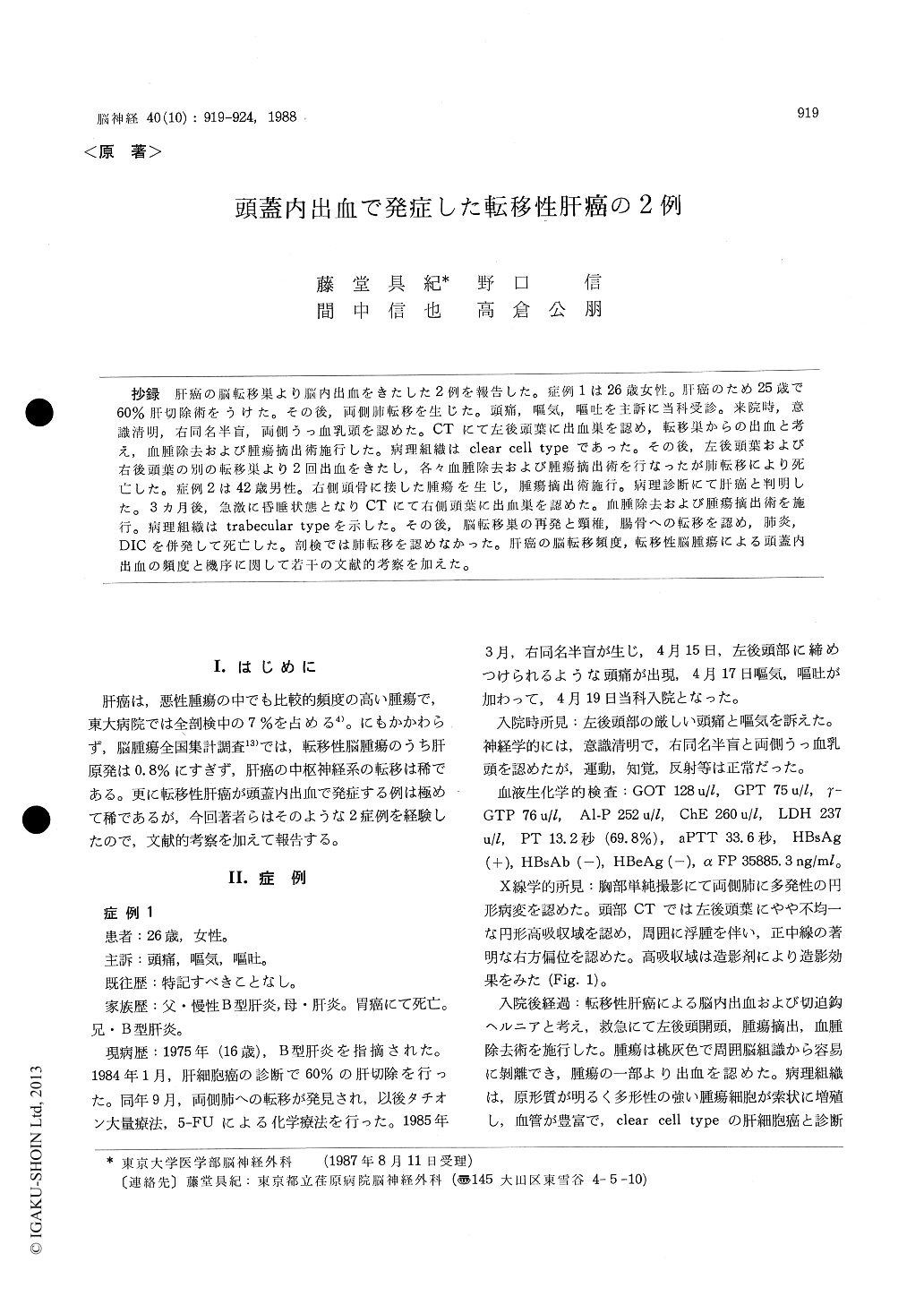Japanese
English
- 有料閲覧
- Abstract 文献概要
- 1ページ目 Look Inside
抄録 肝癌の脳転移巣より脳内出血をきたした2例を報告した。症例1は26歳女性。肝癌のため25歳で60%肝切除術をうけた。その後,両側肺転移を生じた。頭痛,嘔気,嘔吐を主訴に当科受診。来院時,意識清明,右同名半盲,両側うっ血乳頭を認めた。CTにて左後頭葉に出血巣を認め,転移巣からの出血と考え,血腫除去および腫瘍摘出術施行した。病理組織はclear cell typeであった。その後,左後頭葉および右後頭葉の別の転移巣より2回出血をきたし,各々血腫除去および腫瘍摘出術を行なったが肺転移により死亡した。症例2は42歳男性。右側頭骨に接した腫瘍を生じ,腫瘍摘出術施行。病理診断にて肝癌と判明した。3カ月後,急激に昏睡状態となりCTにて右側頭葉に出血巣を認めた。血腫除去および腫瘍摘出術を施行。病理組織はtrabecular typeを示した。その後,脳転移巣の再発と頸椎,腸骨への転移を認め,肺炎,DICを併発して死亡した。剖検では肺転移を認めなかった。肝癌の脳転移頻度,転移性脳腫瘍による頭蓋内出血の頻度と機序に関して若干の文献的考察を加えた。
Metastasis of hepatoma to the central nervous system is rare, although hepatoma is a relatively common malignant tumor in Japan. Much rarer is metastatic hepatoma presenting as intracranial hemorrhage and there have been only 4 cases reported in the past. Here, we report two such rare cases with a literatural review.
Case 1 was a 26 years-old female with a history of 60% hepatic resection in the diagnosis of hepatocellular carcinoma. Later, she developed bilateral lung metastasis. She was admitted with complaints of headache, nausea and vomiting. Neurological findings were clear consciousness, right homonymous hemianopsia and bilateral papilledema. CT showed high-density mass in the left occipital lobe. Evacuation of hematoma and removal of tumor were performed. Pathological diagnosis was hepatocellular carcinoma of clear cell type. Later, two other hemorrhage occurred from different metastatic lesions in the left occipital lobe and the right occipital lobe, and the patient underwent two more surgeries. The patient died of lung metastasis, three months from neurological onset.
Case 2 was a 42 years-old male who developed an intracranial tumor adjacent to the right tem-poral bone without a history of hepatoma. The tumor was removed, which turned out to be hepatocelluar carcinoma pathologically. Three months later, on admission, the patient showed sudden neurological deterioration into deep coma. CT showed an irregular high-density mass in the right temporal lobe and evacuation of hema-toma coupled with tumor removal was performed. Pathology was of trabecular type. Later, intra-cranial recurrence and bony metastasis to C 5, L 3 and the left iliac bone appeared. The patient died of pneumonia and DIC, 9 months from onset. Autopsy revealed no evidence of lung metastasis.
Hepatoma accounts for 0.8% of metastatic brain tumors in Japan. At our hospital, only 5 out of 225 metastatic tumors we have experienced during 35 years (1951-1985) originated in the liver. On the other hand, 0.5% of 5,208 autopsied cases of hepatoma in Japan showed brain metastasis. It is very rare for metastatic hepatoma to present as intracranial hemorrhage, although hepatoma is well known for its peritoneal bleeding, and we have found only 4 cases reported in the past. Generally, 0.6-6.1% of brain tumors is reported to cause intracranial hemorrhage, and it is thefirst presentation in 1/3-1/2 of those cases. There are several theories for brain tumors to cause hemorrhages. One is that hemorrhage occurs at the tumor margin where new vessel formation takes place. Histologically, huge, disorderly, fistulous vessels are described. Another is that hemorrhage occurs at the border of tumor where new rapid invasion occurs, which causes compres-sion necrosis of the adjacent brain tissue.
The prognosis of hepatoma patients is still verypoor, which is one of the most important factors of the low incidence of metastasis to the central nervous system. As the prognosis improves in the future, the incidence of intracranial metastasis is expected to increase and its presenting as intra-cranial hemorrhage may not be so rare, consider-ing hepatoma's natural tendency for tumoral bleeding.

Copyright © 1988, Igaku-Shoin Ltd. All rights reserved.


